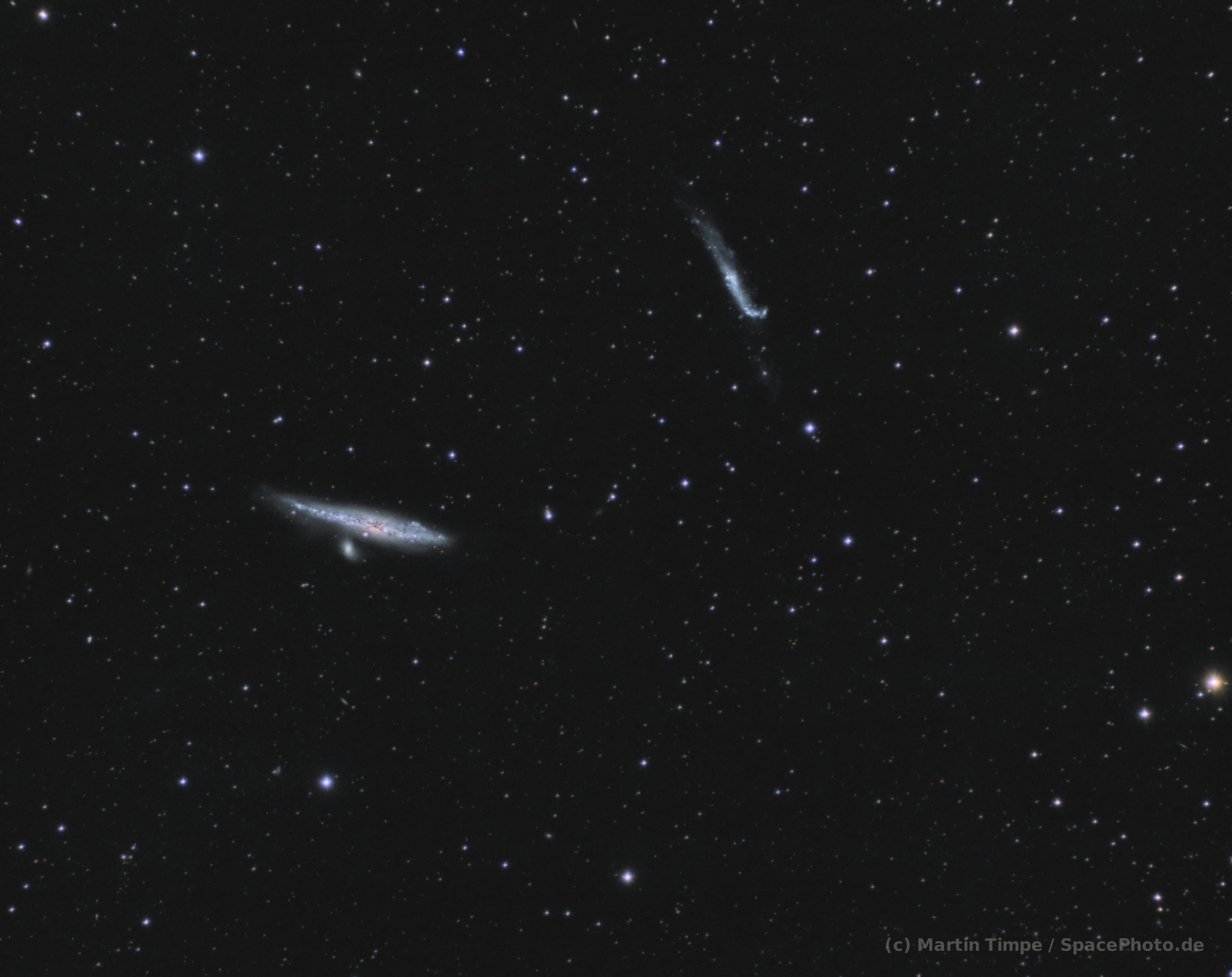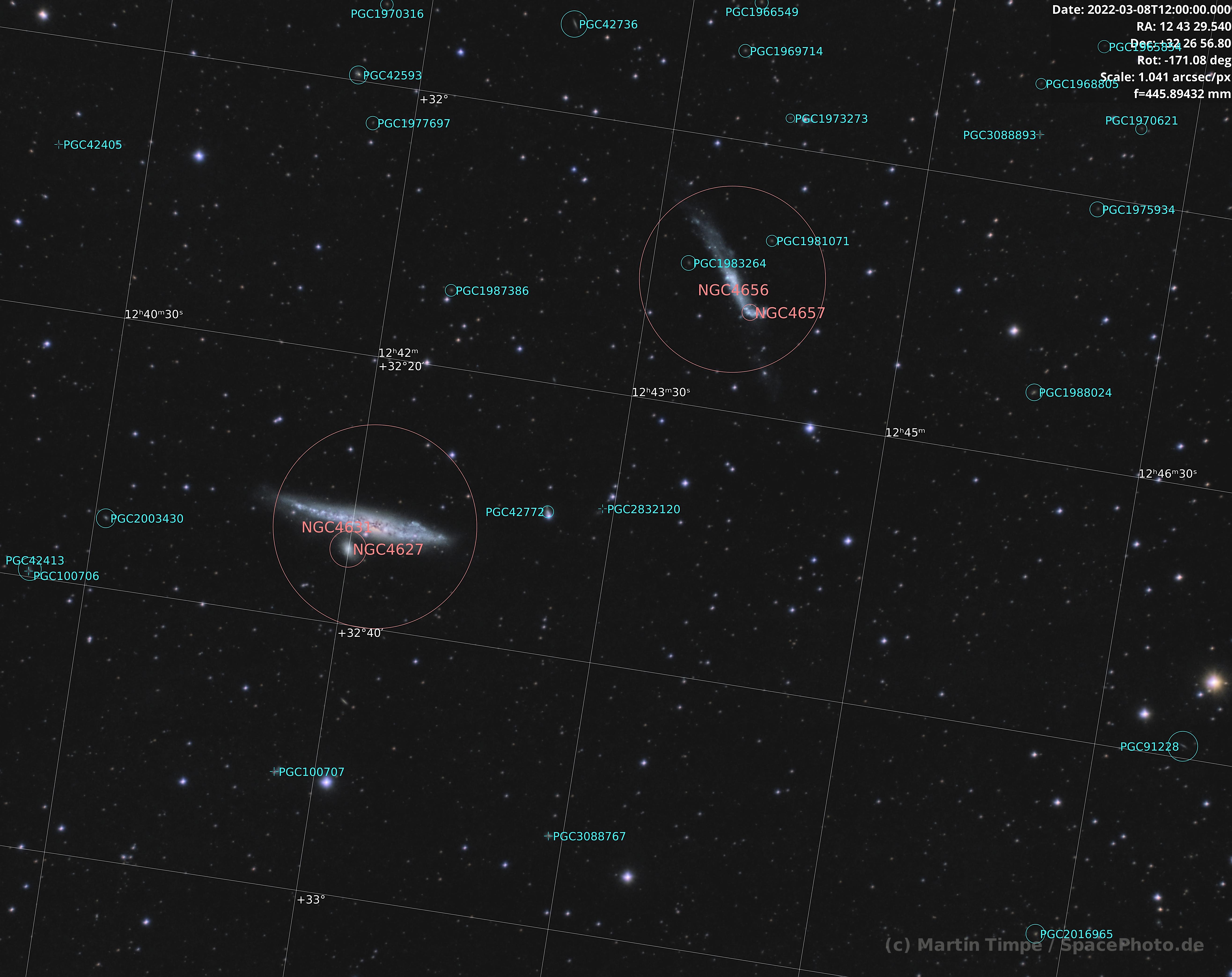"Whale" Galaxie NGC 4631 and "Hockestick/Crowbar" Galaxie NGC 4656/4657
With this picture we dive into the constellation Canes Venatici. The galaxy NGC 4631 on the left half of the image is known as whale galaxy while NGC 4656 and NGC 4657 on the right half of the image pane are known as hockey-stick or crowbar galaxy. The elongated part is catalogued as NGC 4656 while the smaller angled end is NGC 4657.

Bilddaten: "Wal"-Galaxie NGC 4631 und "Hockeyschläger"-Galaxie NGC 4656, Teleskop Skopos f=560x0,8=448mm @f/5.6, Camera Atik 460EXM, 38/25/24/34x300s LRGB
With this picture we dive into the constellation Canes Venatici. The galaxy NGC 4631 on the left half of the image is known as whale galaxy while NGC 4656 and NGC 4657 on the right half of the image pane are known as hockey-stick or crowbar galaxy. The elongated part is catalogued as NGC 4656 while the smaller angled end is NGC 4657. The irregular NGC 4631 on the left side is visibly interacting with a smaller companion, the elliptic galaxy NGC 4627. Between all three galaxies was or is a gravitative interaction that forced NGC 4631 and NGC 4656/4657 into its irregular shape. All three galaxies (NGC 4631, NGC 4657 and NGC 4656/4657) are related to a galaxy group known as "NGC 4631 group" which lacks a clear definition due to the closeness to the huge galaxy cloud of the Virgo galaxy cluster. The distance of NGC 4631 is given by the NASA/IPAC Extragalactic Database as 30 million light years or as a redshift of 606+-3km/s. For NGC 4656 a redshift of 646km/s was determined by the aforementioned database.
As a consequence of the gravitative interaction with its surrounding galaxies NGC 4631 has a irregular shape and in its center a massive starburst starformation regions is visible on the image a yellow/reddish spot. It can be clearly characterized by its emissions from ionized hydrogen and large clouds of dust. The star formation is that massive and active that by the large number of supernovae occurring in it, very hot gas is pushed outside of the galaxy that forms a halo which is visible in X-ray images of the galaxy (NGC 4631 im Röntgenspektrum).
On the image story: In the beginning of March 2022 was a period of clear weather around the waxing moon and close to new moon. I used these night to track deep-sky objects passing my field of view close to the zenith where the light pollution is at it's minimum at my location and the transparency is best (starting with the Rosetta nebula NGC 2237 which was giving its farewell from the winter sky, the LEO1 dwarf galaxy, the open cluster M67 and this interesting galaxy arrangement that forms an attractive motive for my short focal length refractor telescope). All mentioned objects required more exposure time than available within a single night due to visibility restrictions at my site. Therefore the scheduler was set to slew the objects step by step from West to East over the time of the elapsing night. More technical details on the image acquisition in tabular format can be found below the labeled image.
- Technical Image Details:
Refractor f=560mm f/7 with reducer 0.8 yielding f=448mm f/5.6
Camera Atik 460Exm with Baader LRGB filter set
- Exposure Times:
38x300s L
25x300s R
24x300s G
34x300s B
total: 10h 5min
Date: 07-09.03.2022
Location: Bad Kreuznach / Germany
Mount Vixen GPD2 with Boxdörfer Control
Guiding and exposure control using INDI / PHD2 / CCDCiel running on XUbuntu Linux
Image Processing PixInsight and Darktable
